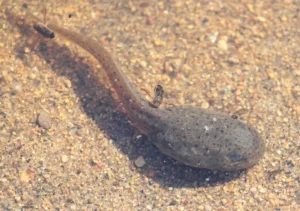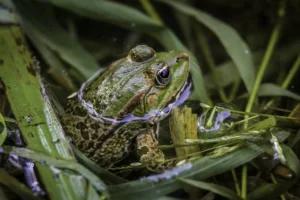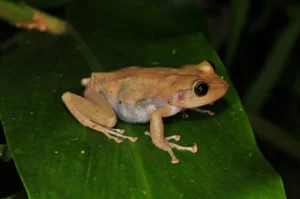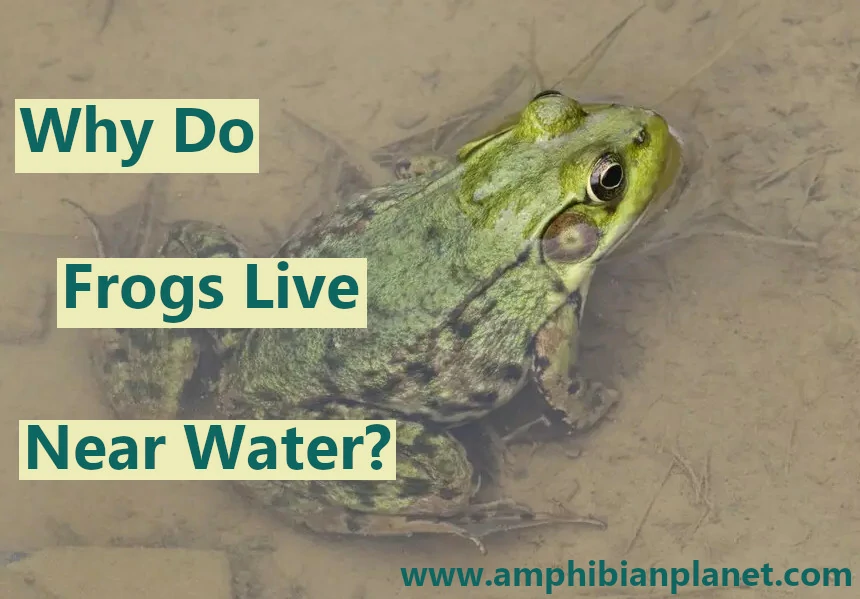Many people know that most frogs love to hang around in or near freshwater bodies, such as ponds, lakes, or streams. But have you ever wondered why frogs live near water?
Frogs live near bodies of freshwater because they need to keep their skin moist. Frogs breathe through their skin, in addition to their lungs, so if their skin dries out, they can suffocate and die.
The higher moisture content in the air near water bodies means frogs’ skins do not dry out as easily. If they start to dry out, they can enter the water to rehydrate and keep their skin moist.
In addition, most frogs are dependent on water bodies to breed.
Most Frogs Start Their Lives in the Water
The majority of frog species lay their eggs in shallow, standing, or slow-moving freshwater bodies that are free of predatory fish.
This could be in woodland ponds, seasonal pools, temporary rain puddles, flooded ditches, lake edges, river backwaters, bogs, marshes, swamps, and even in deep tire tracks or potholes filled with rainwater
After a few days, to a few weeks, tiny tadpoles hatch from these eggs.
Tadpoles are very different from adult frogs; this is because they’re adapted for a fully aquatic life, while adult frogs are adapted for a semi-aquatic, or mostly terrestrial life (depending on the species).

The tadpoles have gills, and live entirely in the water, just like fish.
Over time, the tadpoles will go through a process known as metamorphosis in which they will transform into juvenile frogs.
During metamorphosis, the thyroid gland secretes a growth hormone called thyroxine.
This hormone triggers the tadpoles to:
- Lose the gills, and develop lungs for breathing air
- Absorb the tail into the body
- Grow strong legs for moving on land
- Remodel other organs to form an adult frog

Once this process is complete, tiny froglets will leave the water for a mostly terrestrial life.
These young frogs will grow into adult frogs over time.
Most Adult Frogs Need to Be Near Water to Survive
Although adult frogs can survive on land, most species still require frequent access to water to survive.
They usually hang around cool, humid, shaded areas near ponds, swamps, streams, lakes, and other water bodies.
Here are 4 reasons why frogs live near water:
1. To Keep Their Skin Moist
Frogs and other amphibians have unique skin compared to that of many other vertebrates. Their skin is composed of thin membranous tissue that is quite permeable to water and contains a large network of blood vessels.
This permeable skin distinguishes them from mammals, birds, or reptiles.
Permeability relates to how easily a gas or liquid molecule can pass back and forth from the environment into the animal and vice versa.
Typically, the larger the molecule, the more difficult it is to enter the animal through its skin. Amphibian skin is more permeable than that of other vertebrates.
Their membranous skin allows water and respiratory gases to readily diffuse directly down their gradients between the blood vessels and the surroundings.
To efficiently breathe via their skin, frogs have to keep their skin constantly moist by secreting a special mucous coating (which gives them a slimy feeling when touched).

Frogs can only breathe through their skin if the skin stays moist. If it dries up, they can suffocate and die.
For this reason, frogs generally need to be near water so they can keep their skin moist, and prevent it from drying out.
2. To Cool down and Escape the Heat
Frogs are ectothermic or “cold-blooded” animals, which means they cannot regulate their body temperature. Their body temperature changes as the temperature in their surroundings changes.
When it’s warm, their bodies soak up the heat, and their body temperature rises. When it’s cooler, their body temperature falls.
Since frogs can not generate their own internal heat, they rely on external heat sources such as the sun to keep their bodies at optimal temperatures.
As the temperature changes at different times of day and night, they move around in their environment to regulate their body heat. This is known as “behavioral thermoregulation.”
When their body temperature is low, they move into the sun to warm up, when it is high, they move to the shade or cool water to cool down.
For instance, If a frog’s body temperature is too hot, it may move to the water to cool down.

The water is cooler than the air and not only cools the frog through conduction but also rehydrates it, which allows it to use evaporation cooling to stabilize its body temperature.
3. To Keep Themselves Hydrated
Like all living creatures, frogs need to consume water to survive.
Dehydration can be harmful, and even potentially lethal to most frogs. Their need for water is as critical as their need for food or oxygen–it’s an essential substance, that keeps their bodies working normally.
Frog bodies need a steady supply of fluids to transport nutrients, eliminate waste, and perform many other important functions.
That said, frogs do not drink water through their mouths like we do. Instead, they rehydrate by absorbing water across their permeable skin, in a process known as ‘cutaneous absorption’.

Although most of a frogs’ skin is permeable to water, many frogs have a specialized area of skin located on their belly and the underside of their thighs (the ventral pelvic region), known as the ‘drink patch’, ‘drinking patch’, or the ‘seat patch’. This area of skin is responsible for most of their water uptake.
The drink patch has a very large network of small blood vessels called capillaries. Water absorption across this skin is driven by the osmotic gradient that develops as a consequence of solute transport.
Even though the drink patch skin only constitutes about ten percent of the total skin area, it is responsible for over 70 percent of the total water uptake by many dehydrated frogs.
Frogs need to live near bodies of fresh water in which they can soak and lie – to rehydrate.
In rainy weather, it’s common for frogs to come of out their retreats, and soak in rain puddles on the ground. While they soak in water, they absorb some of the water through their skin and rehydrate.
4. To Reproduce in the Water
The vast majority of frog species require water to successfully reproduce.
Frogs typically lay their eggs in shallow, standing, or slow-moving freshwater bodies that are free of predatory fish.
This could be in woodland ponds, reservoirs, seasonal pools, river margins, lake edges, river backwaters, bogs, marshes, swamps, temporary rain puddles, and even in roadside ditches, deep tire tracks, or potholes filled with rainwater.

Some frog species such as the American green tree frog (Hyla cinerea) occasionally lay their eggs in water bodies with fish.
Other frog species such as the Coastal Tailed Frog (Ascaphus truei), and the waterfall frog (Ranoidea nannotis) lay their eggs in fast-flowing streams, and attach them underneath large rocks.
Some frogs such as the red-eyed tree frog, and glass frogs of South America, do not lay their directly eggs in water. Rather, they lay them on leaves that hang over the water.

When the eggs are ready to hatch, the tadpoles inside start wriggling around, breaking the eggs open.
The tadpoles then wash down the leaf and fall into the pond below.
Some Frogs Can Survive Away From Water
While most frogs need to live near water, some frog species such as the Common coquí (Eleutherodactylus coqui) evolved to live in environments with low availability of undisturbed surface water to live in.
For this reason, they developed strategies that enable them to survive and thrive without direct access to water.
These frogs can re-hydrate entirely by absorbing moisture from moist soil, or any other moist material, such as damp leaf litter.
To reproduce, frogs such as Common Coquis lay eggs in protected terrestrial environments, which then hatch into young frogs that are morphologically similar to the adults. This is known as ‘direct development.’

Depending on the species, the eggs are laid on leaves, in tree hollows, in caves, under logs, in damp soil or leaf litter, and even in abandoned bird nests.
The eggs of direct-developing frogs are usually extra large because they have a lot of yolk to compensate for the lack of feeding as a tadpole.
The yolk will remain attached to the intestine to nourish the froglets for the first few days after hatching, in a sequence similar to chickens.
Such reproductive behavior allows these frogs to live in forests, mountains, and even in urban areas – without the limitation of a direct dependency on water.
Common questions
Why do frogs need to live in damp places? Frogs need to live in damp places to stop their permeable skin from drying out. Frogs breathe through their skin, in addition to their lungs, so if their skin dries out, they can suffocate and die.
Why do frogs need to live in ponds? Frogs are semi-aquatic creatures. They need to live in or near ponds to keep themselves cool and to prevent their moist skin from dying out. In addition, most frogs breed in ponds, or other freshwater bodies.
Sources:
P. J. Bentley, T. Yorio; Do Frogs Drink? J Exp Biol 1 April 1979; 79 (1): 41–46. doi: https://doi.org/10.1242/jeb.79.1.41
Sarah E Westrick, Mara Laslo, Eva K Fischer (2022) The Natural History of Model Organisms: The big potential of the small frog Eleutherodactylus coqui eLife 11:e73401 https://doi.org/10.7554/eLife.73401


